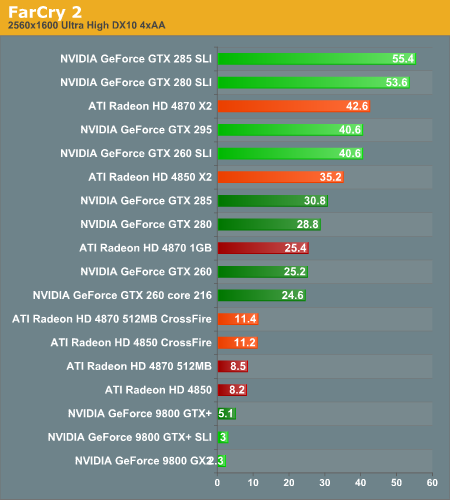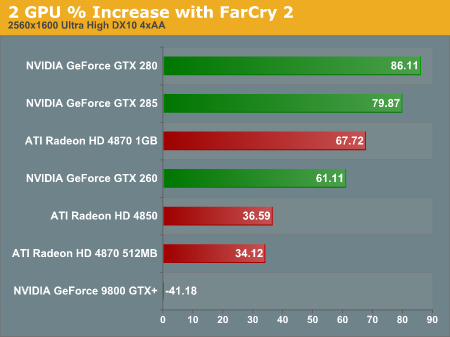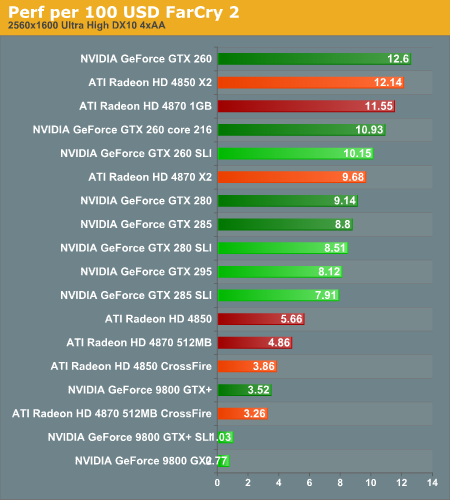MultiGPU Update: Two-GPU Options in Depth
by Derek Wilson on February 23, 2009 7:30 AM EST- Posted in
- GPUs
FarCry 2 Analysis
FarCry 2 is a good looking game with a well rounded graphics engine. We use the benchmark tool and a custom demo to test with ultra high graphics options while we try to minimize CPU impact.

1680x1050 1920x1200 2560x1600
Relative performance stays very consistent from 1680x1050 to 1920x1200 but looking at 2560x1600 tells a different story. Anything with 512MB of RAM just tanks in performance at the highest resolution. CrossFire and SLI can't help these lower memory parts keep up either. Even at lower resolutions it seems like the G9x based NVIDIA hardware just can't handle FarCry 2 very well at all. This make the 4850 a much better option than the 9800 GTX+.

1680x1050 1920x1200 2560x1600
As for scaling, SLI does really well with GT200 based cards and not so well with the 9800 GTX+. CrossFire scaling is very consistent between 1680x1050 and 1920x1200. Everything drops in scaling at 2560x1600 though. We expect that this is because of the increased memory and bandwidth requirements from the higher res.

1680x1050 1920x1200 2560x1600
Performance per dollar reveals the GTX 260 and GTX 260 SLI as the only NVIDIA options with value that competes with AMD solutions below 2560x1600. At the highest resolution, because of the memory limited performance issues, the value of our 512MB ATI cards drop to near the bottom of the heap. The Radeon HD 4850 X2 2GB is consistently high in value here and remains playable across all resolutions.
The settings we chose leave the G9x based parts (even in SLI) and the Radeon HD 4850 unplayable even at 1680x1050. Radeon HD 4870 level hardware and above can achieve the highest visual quality at the lowest res we tested. Pushing up, the 512MB 4870 drops a bit too much in performance to recommend at 1920x1200. The 1GB version of the 4870 holds on to playability and leads the GTX 260 core 216. At 2560x1600, the only single GPU option that barely gets by is the GTX 285. CrossFire and SLI (as long as the cards have more than 512MB of RAM) seem to have enough under the hood to run at the highest settings and resolution.










95 Comments
View All Comments
kmmatney - Monday, February 23, 2009 - link
Especially at the 1920 x 1200 resolution - that resolution is becoming a sweetspot nowadays.just4U - Monday, February 23, 2009 - link
I disagree. I see people finally moving away from their older 17-19" flat panels directly into 22" wide screens. 24" and 1920/1200 resolutions are no where near the norm.SiliconDoc - Wednesday, March 18, 2009 - link
Correct, but he said sweet spot because his/her wallet is just getting bulgy enough to comtenplate a movement in that direction... so - even he/she is sadly stuck at "the end user resolution"...lol
Yes, oh well. I'm sure everyone is driving a Mazerati until you open their garage door....or golly that "EVO" just disappeared... must have been stolen.
DerekWilson - Monday, February 23, 2009 - link
The 1GB version should perform very similarly to the two 4850 cards in CrossFire.The short answer is that the 1GB version won't have what it takes for 2560x1600 but it might work out well for lower resolutions.
We don't have a 1GB version, so we can't get more specific than that, though this is enough data to make a purchasing decision -- just look at the 4850 CrossFire option and take into consideration the cheaper price on the 1GB X2.
politbureau - Tuesday, June 1, 2010 - link
I realize this is an older article, however I always find it interesting to read when upgrading cards.While I find it admirable that Derek has compared the 'older' GTX 280 SLI scaling, it is unfortunate that he hasn't pointed out that it should perform identically to the GTX 285s if the clocks were the same.
This was also passed over in the "worthy successor" article, where it does not compare clock for clock numbers - an obvious test, if we want to discover the full value of the die shrink.
I recently 'upgraded' to 3 GTX 285s from 3 GTX 280s through warranty program with the mfg, and there is little to no difference in performance between the 2 setups. While cabling is more convenient (no 6 to 8 pin adapters), the 285s won't clock any better than my 280s would, Vantage scores are within a couple hundred points of each other at the same clocks (the 280s actually leading), and the temperature and fan speed of the new cards hasn't improved.
I think this is a valuable point in an article that compares performance per dollar, and while slightly outside the scope of the article, I think it's a probabtive observation to make.